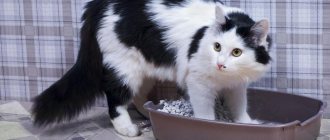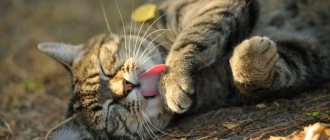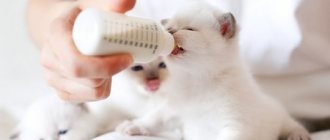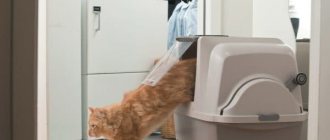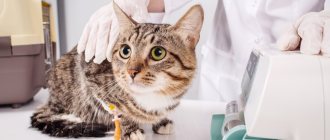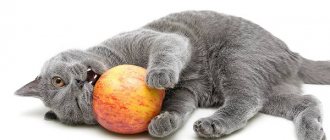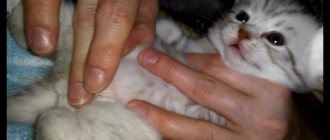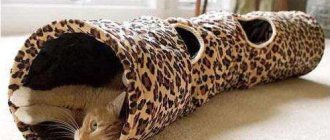The appearance of an animal in the house is by no means an ordinary event. Any living creature needs affection, care and proper care. Small pets require special attention. Unfortunately, many of us, trying to enliven our home with the presence of a kitten, do not even think about how comfortable the baby will feel in unfamiliar conditions.
In addition, not knowing when kittens begin to eat themselves can cause colossal harm to the body of a small creature. It is important to take care of your pet’s proper diet from the very first days, to know how and what to pamper him with.
Urination and defecation in kittens by age
A spontaneous reflex to urination and stool in babies occurs at three weeks of age.
During the first time after birth, small kittens are not able to cope with the need on their own.
The process of releasing urine and feces occurs with the help of certain efforts of the mother, who, by massaging the tummy area, activates the defecation reflex, and then licks the kitten.
The process of digesting food in kittens involves defecating up to 10 times daily. When the cubs are with the mother, she takes care of it.
In the absence of a cat, small pets should be stimulated to defecate once every 2-3 hours, preferably before and after meals. In order to remove feces and wipe the kitten, use cotton wool discs soaked in warm clean water or pieces of a soft cloth.
The spontaneous reflex to urination and stool in babies occurs at three weeks of age.
How to teach a kitten to eat itself?
First, you need to accustom the kitten to the saucer so that it can eat from it on its own. At first, the baby may walk in circles around the bowl, smelling a familiar smell. Help him determine where he is coming from. Poke your pet's muzzle into the saucer . If he did not immediately understand what to do, but showed interest in food, try again several times. After some time, the pet will begin to eat on its own.
To teach a kitten to eat on its own, you need to take into account the following rules:
- To begin with, give your pet his usual food - milk. Introduce new foods into his diet gradually.
- When the kitten begins to eat milk itself, you can experiment with the density of food and give it semolina porridge.
- There should always be water next to food, renewed as it gets dirty.
- Do not overfeed your pet. If the kitten is hungry, it will meow loudly and try to find the cat.
It will take several weeks to teach a kitten to eat from a bowl. Only after this you need to take the next steps to educate your baby.
© shutterstock
How often should a one-month-old kitten go to the toilet?
During the first 20-30 days after birth, kittens strengthen their intestines and multiply beneficial bacteria in them, which helps to activate bowel movements.
It is considered normal for kittens to go to the litter box approximately 3-6 times a day at one month of age. At the same time, the feces do not have a very thick consistency, with the absence of elements of blood, mucus and pieces of poorly processed food.
Be sure to read:
How many times a day should a cat pee: the norm for an adult animal and kittens, when deviations are safe
The pet owner should monitor the amount and density of feces excreted. A deviation from the norm is the presence of liquid stool and constipation.
Also, the quality of functioning of the animal’s digestive system is determined by palpating the abdominal area. In healthy babies, the abdomen is soft, touching it does not cause pain.
Details of the development of cat paws
Owners of kittens get a lot of pleasure admiring the charming and funny babies. But they are also responsible for the development of their students. And for this, owners need to know how cat babies should grow and develop correctly. After all, its safety, health and dexterity depend on how correctly the animal’s motor apparatus is developed.
Stage-by-stage development of kittens' paws:
- 0-7 days . Tiny mole rats crawl on their bellies, using their front, still fragile, legs. They can’t stand on them yet; in fact, they don’t even try.
- 7-12 days . There is an intensive development of sensory skills. Kittens are already able to detect odors from a distance. The forelimbs are strengthened as babies move them over the cat's belly.
- 12-14 days . The kittens' eyes begin to open and they become more confident in their movements. Although their vision these days is rather poor. The babies rise to their paws, and their hind limbs also develop, receiving a feasible load.
- 14-20 days . The musculoskeletal system is strengthened, joint tissues become stronger and more elastic. The kittens are already walking on their own, but still staggering and stumbling.
- 40-60 days. Kittens at this age become very active and restless. They jump, tumble and run all over the house. For them, this is a very exciting period, while for the owner, this endless movement, pranks and flickering underfoot can cause dissatisfaction. But cat lovers know that their pets often remain cheerful for many years and there is no point in scolding your furry pet for this.
Recommendations for owners
Not all cat lovers are experienced in kitten development, so it is important to know some nuances:
- Don't be scared when newborn babies lie down and don't even try to get up on their paws. On the first day, this behavior is the norm; their limbs are initially very weak.
- As soon as the birds begin to leave the nest and become interested in their surroundings, all dangerous objects should be removed from its path.
- It is forbidden to lift or pull the kitten by the paws or remove it with your foot.
- It is advisable to prepare in advance for the upcoming activity of children. After all, the owner won’t have time to look back before they go exploring the house.
How to determine that a kitten wants to go to the toilet
The process of accustoming a small furry pet to using a litter tray is gradual, requiring a sufficient amount of time and endurance on the part of the animal's owners. To determine when your baby wants to go to the toilet, you need to monitor his behavior.
The most common signs:
- scratching the floor, flooring (“digging” a hole for future work);
- sniffing objects around you;
- marking time, restlessness;
- meow.
Having noticed actions signaling a possible bowel movement, it is recommended to immediately place the kitten on a tray with a special filler.
Nutrition after 1.5 months
Later, closer to two months, you can give boiled meat and fish. It’s also worth pampering your pet with fresh fish, but only occasionally. Be sure to make sure that there are no large seeds in the product. It is recommended to give food in small pieces; mixing meat or fish with any porridge cooked in water is acceptable. The best food option for a small kitten is ready-made canned food, which can be easily purchased at any supermarket. However, it is first necessary to clarify at what time the kittens begin to eat such food themselves.
When does a kitten begin to feed on its own?
Upon reaching the age of one month, the digestive organs of a cat cub are fully formed and filled with beneficial bacteria.
The basis of nutrition is mother's milk, but it must be gradually supplemented with other products that facilitate the baby's transition to independent feeding.
The main food elements included in the list of possible complementary foods:
- thin porridge;
- pate from boiled meat, fish;
- lactic acid products.
Pet owners need to familiarize themselves with the main rules for introducing complementary foods for kittens:
- The transition should begin by giving warm milk. If the kitten does not understand how to lap, it is recommended to gently poke the pet’s muzzle into the drink. By licking himself, he will understand how to act.
- Then you can offer your pet thin porridge or meat pate.
There are also industrial feeds for feeding kittens. They can be started from 1 month.
At first, you will have to wipe the kitten after each meal. Gradually, he will learn to do everything carefully and independently clean his face of food debris.
Be sure to read:
Antigadin for cats: purchased and homemade products
Nutritional features of kittens
I would like to immediately note that kittens in their development go through almost the same stages as our children. They are born completely helpless. During the first weeks, the cat mother takes care of all the newborn babies. But this time passes, and the fluffy fidgets are already running around and playing with pleasure. This is exactly the period when the kitten begins to eat itself: first milk, and a little later - more serious food. The owner must teach the baby to eat independently, develop correct behavior, and provide a nutritious diet.
Although kittens can feed on mother's milk for up to two months, by the end of the third week they are no longer satisfied with such a limited menu. They show interest in the contents of their mother's plate. Kittens try to taste adult food. Of course, at first nothing works out for the kids. Therefore, a person is obliged to help his pet at the initial stage. In the first days, when the kitten begins to eat on its own, it is best to give it very liquid porridge cooked in milk.
With the appearance of the first milk teeth, and this happens at the age of two months, you can gradually accustom the baby to solid food. When the kitten is two and a half months old, he will be able to eat any food. At the same time, he will gradually wean himself off his mother's milk.
Features of defecation, possible problems and what to do
At the initial stage of introducing complementary foods to kittens, problems may arise related to the individual characteristics of the functioning of the digestive tract of animals:
- constipation;
- diarrhea;
- excretion of feces mixed with blood and poorly digested food.
To identify the cause of defecation disorder, you should monitor the kitten's condition. A period of no bowel movements of up to two days is considered acceptable, provided there is a good appetite.
You can try adding a small amount of Vaseline oil to your baby’s food, massage the tummy and monitor for 1-2 days.
If bowel movement does not occur after the manipulations performed, the pet must be urgently shown to a veterinarian to identify the cause and effectively solve the problem.
Diarrhea or the presence of pieces of poorly processed food or blood in the stool may indicate that the digestive system is not coping properly with the food components newly added to the menu. In such cases, the complementary feeding diet should be reconsidered or the dosage of products should be reduced.
Why might a kitten refuse to eat?
Sometimes the kitten refuses to eat on its own. This may happen because you started training him too early. In this case, it is better to return to feeding from a pipette or with the help of a cat. After some time, you can return to the science of independent nutrition.
The baby will not be able to start feeding on his own if the bowl is too uncomfortable. It may be large or slip on the floor covering. Buy him a bowl that fits his size and is stable on the floor. Then the small animal will feel comfortable and will be more willing to eat.
Your baby may not like food if it is too hot or cold. It is better to feed him food at room temperature. In addition, the animal may have health problems that prevent it from being able to feed itself. At the first sign indicating this, contact your veterinarian.
Further development
In the second and third months of life, the kitten's development continues. His eye color becomes permanent. The kittens have learned to find a bowl and litter box, love to interact with people, and are generally ready to go.
At two months, nutrition switches to special food or so-called “natural food”; kittens drink mother’s milk only to feel a pleasant taste and warmth. It is worth feeding them 5 times a day and monitoring how much they eat. There must be water constantly. During this same period of life, one of the most amazing feline skills manifests itself - purring. Kittens are very active and strive to explore more and more places, so it is easier to remove all dangerous objects than to build fences. Even the meter option will be overcome in a couple of days.
The first vaccinations should be given at 2-2.5 months. Usually there are two of them - rabies and complex. They can add seasonal ones, that is, characteristic of a particular year. But all vaccinations are optional for pets. They are checked at exhibitions and when crossing state borders.
At three months the kitten gets used to using its name. Weight reaches one kilogram or approaches one and a half kilograms.
Kittens at 5 months already resemble adults
At 4-5 months, a kitten is considered a teenager. Weighs 1.5-2 kilograms. He is taught hygiene procedures. He grows and takes on the features of an adult cat, stretching out and getting bigger. The cat plays less with toys, communicates more with people and sleeps, finding his favorite places in the house. By the end of the fifth month, the pet can be switched to three meals a day. Just at this moment, milk teeth begin to be replaced by permanent ones.
At 6-7 months the baby goes through puberty. The teeth are starting to change. The pet may become restless and annoying, even marking its territory or showing aggression. All this is due to hormonal changes. Weight at this time reaches an average of 2.5 kilograms. Externally, the animal looks completely like an adult, with smooth and graceful movements. Beginning shedding, which owners should help with to avoid the formation of hairballs in the stomach, will now occur periodically.
8 month old kitty
From 8 months, growth practically stops, weight becomes stable. Temperament, character traits and the result of upbringing are revealed. You may be thinking about castration or sterilization. From 10 months you can switch to adult food, the growth phase ends.
How to accustom a kitten to a change in diet
If the owner plans to feed the pet natural food, then it is worth thinking about the diversity of the diet. Introducing your pet to new foods and dishes is not difficult. Some recommendations:
- the introduction of new complementary foods should occur gradually;
- a small amount of the product is combined with the baby’s usual food;
- when the animal refuses to try, you need to apply a little on your finger and let him lick it off.
Important! You should be prepared for the fact that your pet will refuse new food. In this case, you need to try to offer something different.
Do the same when switching to dry food. Combining homemade food with store-bought mixtures is harmful and unsafe. But if the owner decides to change the diet, then for a certain period it is worth deviating from the rule.
To switch to dry formula, it is crushed and mixed with the baby’s main food. Every day the amount of feed is increased, gradually homemade food will be replaced. During this period, the kitten’s body needs more water.
Power change scheme
Some useful tips
Experienced people advise that when a kitten begins to eat from a saucer on its own, you should not immediately give it potatoes, pieces of bread or dry foods. A small organism must get used to new food. Let the adaptation period be comfortable for him.
Don’t forget to give clean water to a kitten that is starting to eat on its own. Don't be upset if he drinks a little. The fact is that animals receive the required amount of liquid with food. Many owners complain that when kittens start eating on their own, they cannot determine whether they have enough food. This is easy to understand by assessing the condition of the tray: if the baby visits it regularly, it means he receives a sufficient amount of food.
How to protect a kitten starting to walk on its own
It’s not for nothing that they say that a kitten is the same as a child. He still doesn’t understand many things, which screaming and violence definitely won’t help him with. Kittens often get into trouble when the premises are not properly prepared, or even without that. They may be attracted to the back of the sofa, curtains, tablecloth, wires, carpet, household chemicals, and various narrow and high places. All this is for testing and subsequent assessment of your capabilities.
Examples of equipment for kittens depending on age
Sudden and strong movements of both the kitten and its owners (especially children) are dangerous. The bones are thinner than they might seem, and the paws can easily dislocate or crack the bone tissue. Kicking, even smooth ones, is extremely dangerous. You may accidentally step on your paws by staggering or being distracted by something. It is forbidden to pull the paws and spread them to the sides.
If the baby needs to be transported, it is better to constantly hold him in your arms, since any shaking in transport can cause a fracture, dislocation or crack.
Do not sit your pet on chairs, sofas or other high surfaces. If you let your guard down a little, you might not notice how your baby will fall and hurt himself. It’s better not to lift it high, considering how nimble and fast they are, not yet able to control their sharp claws. We do not recommend placing small kittens on slippery floors, as this will prevent them from learning to walk normally.
In what cases should you contact a veterinarian?
An alarming signal is a long refusal to go to the toilet, as well as the presence of too dry or excessively loose stools. In these cases, you should not postpone going to the veterinarian. This same advice applies to those cases when a kitten does not visit the litter box for more than a day and its fur begins to smell unpleasant.
If it is noticed that the urination process causes discomfort to the cat, the amount of urine produced is too small, you should regard these as quite dangerous symptoms and immediately contact a veterinary clinic. The sooner you see a doctor, the sooner treatment will begin.
No less obvious signs of pathology requiring specialist intervention are the presence of blood, sand, or mucus in the urine, a swollen tummy, fever, lack of appetite, apathy, dry ears and nose.

